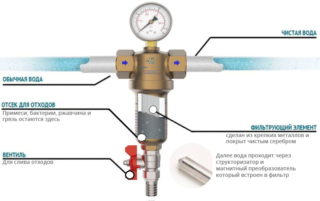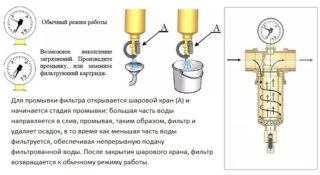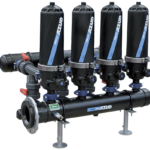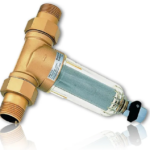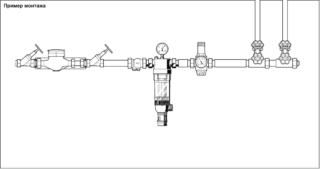Poor water quality adversely affects human health and equipment. To improve the parameters of the liquid, special devices are used, which must be changed periodically. The self-cleaning filter for cold water ensures the continuity of the water purification process, does not require time-consuming disassembly of the device and its manual cleaning.
Purpose and scope of self-cleaning water filters
- The scope is not limited. The equipment is installed on both metal and plastic pipelines in the direction of flow wherever filtration is required with the possibility of cleaning without disassembling the case.
- Cleaning from various mechanical impurities allows you to improve the quality of the product used for drinking and cooking at the outlet, as well as extend the service life of household appliances and industrial units.
The self-cleaning filter allows you to restore the operating parameters of the cleaning element without requiring replacement of cartridges. The design features of some models make it possible to perform self-cleaning without interrupting the operation of the device.
Principle of operation and device
The filtering material is: porous disc structures, plastic or metal cellular elements, compacted backfill. Due to the ease of maintenance and high strength characteristics, the first two options are most often used.
According to the principle of operation, the equipment is automatic and semi-automatic. The first type does not require external intervention for service. The mechanism starts on its own after the clogging sensor, timer or full alarm is triggered. In semi-automatic devices, the flushing process is switched on by a person.
In household appliances, devices are mainly installed, which are in the form of a flask with a fine-mesh mesh, capable of retaining a wide range of inclusions. Contamination accumulated on the surface of the filter element gradually clogs the cells and interferes with the passage of the liquid. The pressure in the system decreases, the cleaning system is activated. The drain valve is opened and the impurities are flushed into the discharge channel or into a special tank under the drain hole.
Varieties of filters
The cleaning process can take place in two ways. In the first case, the action occurs due to the supply of liquid in the opposite direction with a special turbine or air flow from a pneumatic line. In the second, work is performed by means of a tightly pressed stationary scraper. When rotated, the filter element rotates so that contamination is removed from the surface.
Disc self-cleaning filter It is used for the initial purification of water from the mud fraction in water treatment systems of various industries, water mains and cooling systems. The device consists of a set of high-strength discs, located inside the body, tightly pressed against each other, with grooves applied to them, the size of which determines the degree of the final product. When the device is working, the liquid passes through the filtration channels, impurities are retained and then removed during flushing.
Mesh devices are used for cleaning from suspensions and therefore are installed in front of reverse osmosis systems, u / f treatment and in drinking water purification systems. There are vertical and horizontal aggregates with mesh elements located inside, on which suspended particles are retained. The self-cleaning system is: electric - a rubber brush cleans the surface of the element, and a suction scanner removes particles; hydraulic - the action is based on the suction of impurities into plastic nozzles.
FMO - an apparatus for industrial use with a stainless steel wire frame filtering element, the parameters of which depend on the performance of the model. The models have an automatic way to remove mechanical impurities without interrupting the main work process. The design is unevenly divided by a butterfly valve that controls the redirection of the fluid flow to clean the element from contamination. The process is monitored by a local control system with a programmable controller: when turned on, water is supplied to the filter, the air vent opens and the pump turns on, after the air is released, the outlet valve opens.
Flushing is carried out in stages. Initially, the inner part of the mesh is washed, and contaminants enter the drainage manifold. Then the outside is cleaned. Then the inner flap rises perpendicular to the flow and diverts it to flush the most dirty rear part. The drain valve is operated manually or automatically.
Criterias of choice
The devices consist of a metal or plastic case with two holes on different sides for connection to the mains and external thread, a filter element, a generator, as well as a drain valve and a case.
Some models are equipped with additional devices: a pressure gauge to control the degree of pollution, a pressure reducer. However, the way to remove dirt may differ from model to model and this should be taken into account when choosing.
- The pressure, water temperature and other parameters of the system to which the device is connected must correspond to the technical characteristics of the filtering device.
- For water systems with increased load, it is better to use devices with automatic and semi-automatic type of service.
- Filtration designs are classified according to the size of the trapped impurities. Aggregates for fine cleaning stop particles of 20–50 µm, and coarse ones filter inclusions with parameters of 100–500 µm.
- Products with mesh elements are inferior to disk products in performance, but at the same time their maintenance does not cause problems.
Housings of devices for filtering hot and cold water differ from each other. Models designed for cleaning high-temperature liquids are made of a stronger material that does not deform when heated.
Installation features
- The apparatus is located in an upright position with the flask down, taking up a small space. The liquid enters through the inlet, passes through the cleaning cells, leaving dirt with impurities on them, after which it is supplied under pressure to the tap.
- At the bottom of the flask there is a hole that is closed during normal filter operation. If the pressure has become weak, it must be opened.The fluid flow will begin to press downward and the filter is flushed. Then the valve closes again.
- For some models, the design provides for the connection of the drainage hole to the sewer system. If such an opportunity is not provided by the developers, when flushing, a container is installed under the apparatus to collect the liquid.
The degree of cleaning depends on the density of the filter element. The denser the material and the smaller the cells, the better the final result and the more often you have to flush the devices.
Advantages and Disadvantages of Using Self-Cleaning Filters
Like any equipment, these designs have their pros and cons. The positive aspects include:
- minimum time spent on maintenance, plumbing work is carried out very quickly;
- no need to purchase replacement cartridges;
- the possibility of continuous use of purified water - the designs of some models provide for a continuous filter cycle, it does not need to be turned off even during flushing.
The disadvantages include the high cost of devices due to a more complex technical process.

